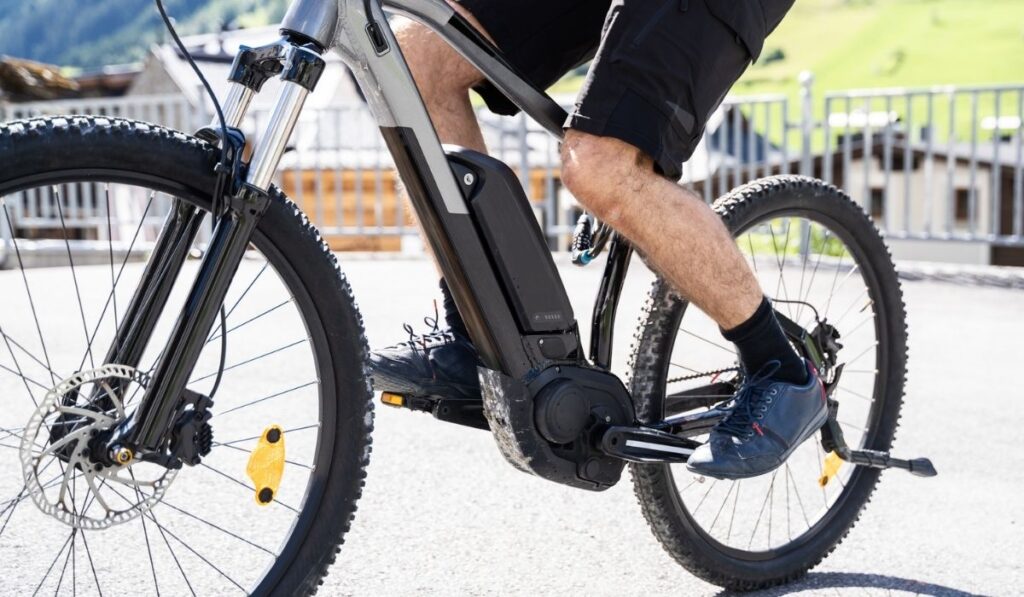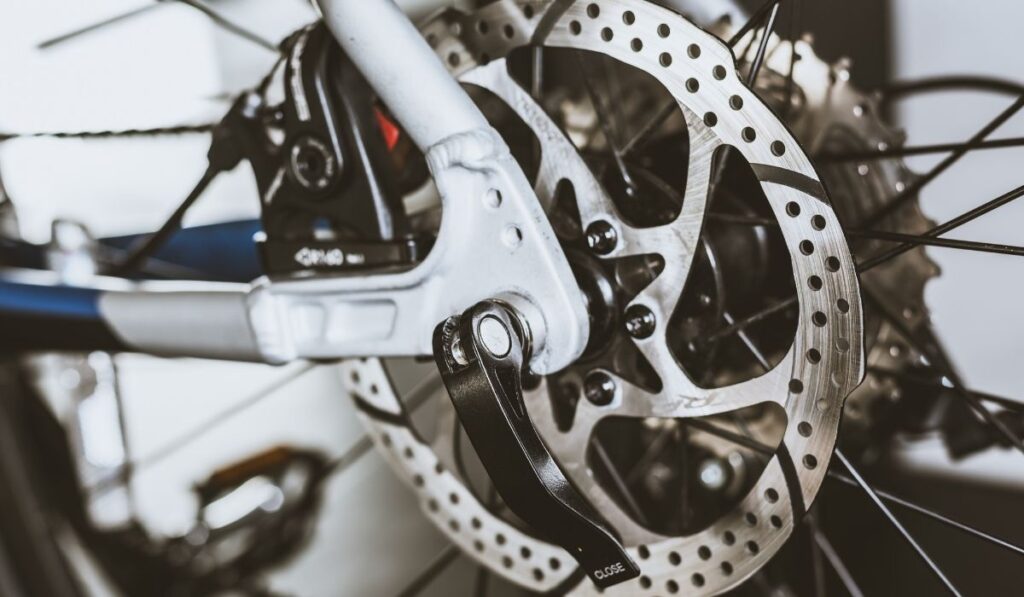Most electric bikes come with pedal-assist systems. These systems offer motor assistance in tandem with your pedaling. But does this process actually help you recharge your bike?
Pedaling and pedal-assist don’t charge an electric bike. Pedaling does reduce the power needed from the battery. This extends the range and battery lifespan over time. Some niche bikes have regenerative braking, but it’s expensive and only recovers 5-15% of the energy used.
So, if pedal-assist doesn’t help charge your bike, what can? If you’ve ever wondered about regenerative braking in electric bikes, read on for the full details!
Understanding Power Recycling Options on an E-Bike

You probably know most electric bikes come with pedal-assist features and systems. These systems work in tandem with your power. Some bikes, Class 1 specifically, only have pedal-assist, and we think these bikes are a tremendous value. But do these systems charge the bike or save energy in any way?
Pedal-assist systems don’t directly charge electric bikes. However, adding your power and energy does take a load off the battery and motor. Taking the strain off the battery and motor can save you energy, thus saving your battery and could even prolong its charge or lifespan.
If you need more range out of your E-Bike, we have a whole separate article about how to get the most range out of your bike. That said, using pedal assist and your riding behavior is one of the best things you could do.
However, if your e-bike has regenerative braking, that’s a different story. With regenerative braking, you may be able to save power going up hills or traveling through the city. But do e-bikes have this feature enabled?
Do E-Bikes Have Regenerative Braking?
Regenerative braking was invented in 1967. This technology is commonly used on electric vehicles, including models from Tesla. Some electric bike models do have regenerative braking, but it is rather rare on electric bikes.
If this is what you’re after, some models like the RadCity 4 offer the system. But, what exactly is regenerative braking, and how does it work?
What Is Regenerative Braking and How Does it Work?

Regenerative braking is a system that captures some of the energy used when braking and feeds it back into the battery. Only electric bikes with direct drive hub motors can have regenerative braking.
With traditional bikes or e-bikes, brake pads will clamp down onto steel rotors to slow down the rotation of the wheels. This process turns the kinetic energy in the rotating wheels into heat, and typically this energy goes nowhere and is just wasted.
But the regenerative braking system works a little differently. Instead of taking the kinetic energy and turning it into heat, the system harnesses it and converts it into electrical power before feeding it back to the battery.
How Effective is Regenerative Breaking on E-Bikes?
The exact number varies quite a bit. In some cases, you can get 1% energy recovered. In other cases, you can get between 5-15%.
The amount of energy recovered will depend on the environment and how often you use the brakes. In flat areas, you are going to recover a lot less energy. However, in hilly city commutes or generally hilly regions, you can increase this amount significantly.
A general rule of thumb is that 5% energy is recovered in flat city commutes, and 10% during hilly city commutes, and 12-14% in hilly areas. But, what does this percentage actually mean?
Well, if you were recovering about 5% energy, you would be recovering 0.05 miles per mile ridden. With 10%, this goes up to 0.1 miles. And at the high end, you can get about 0.15 out of a mile.
So, on a 10-mile commute, you may gain 0.5 miles or even 1.5 miles. Now, this is just a rough estimate, and of course, everyone’s mileage will vary slightly.
Will Regenerate Braking Damage My Brakes?
Regenerative braking should not cause any damage to your brakes and may even be better for them than a traditional braking system.
With conventional braces on typical breaks, you’re using heat to slow down. This heat causes wear and tear on the brake pads and rotors over time. This is why you often hear people telling you not to slam on your brakes too much.
However, with regenerative braking, the motor provides some of the energy used to brake. The motor providing power could potentially take the strain off the brake pads and rotor, causing them to last longer.
Why is it Hard To Find E-Bikes With Regenerative Braking?
Most electric bikes won’t have regenerative braking. In fact, only a few models do have such a system. Why is this?
Regenerative braking technology is rare because it requires a certain type of motor that isn’t used often. Regenerative braking systems need a direct drive hub motor. This motor type is less common and comes with its own disadvantages.
On top of that, this technology adds a lot of heat to the battery. This extra heat can cause the battery to break down faster than it would normally.
So to counteract this, manufacturers often need to use higher-quality and premium parts in their batteries. This price increase can affect their costs and profits down the line.
Finally, the percentage recovered isn’t that high and may not warrant the extra work required. 5 to 10% isn’t exactly a ground-breaking amount, and most riders won’t even notice a difference. Add that to the other factors, and regenerative braking doesn’t seem like a viable add-on.
Because of these reasons, regenerative braking technology is usually only found on premium or niche models.
Should I look For a Bike With Regenerative Braking?
You may see the benefits of regenerative braking and wonder if it’s really worth it. So, should you look for bikes with this specific technology?
The answer isn’t definitive. Some riders may benefit a tremendous amount from this technology, while others may not notice at all. That being said, it is a real technology that can be used very effectively and not just a marketing scheme.
If you live in hilly areas and do a lot of city commuting, you may be one of the individuals who can benefit from regenerative braking. If you were looking to swap out your car for an e-bike and had these circumstances, regenerative braking might pay off in the end.
However, if you aren’t doing a lot of city commuting or don’t live in a hilly area, you may not want to shop specifically for regenerative braking. This technology will increase the overall price of your e-bike, and you may not receive the full benefits.
The added expense could be put to better use by investing in other areas of your bike and gear. So, really it will depend on your needs and preferences. If you like the technology or think you’ll benefit from it, then it may be worth it to look for a model that offers it.
Pedaling Does Extend an E-Bike Battery’s Life
As mentioned earlier, pedaling or using pedal-assist won’t directly recharge your battery. However, adding in your power in tandem with the motor does positively impact the battery.
Regenerative braking recovers power when you brake. Regenerative braking happens whether you’re coming to a stop or managing your speeds going downhill. Pedal-assist or pedaling, however, doesn’t recover any power or add any charge.
However, using pedal-assist and pedaling takes some of the strain off both the motor and battery. Taking the stress off can increase both the range and lifespan of these electrical components. That’s why you often come across advice regarding using pedal-assist to get more range out of your electric bike.
How to Get The Most out of Pedal Assist
Even though pedal-assist doesn’t technically recharge your battery, you can still use it to prolong your battery’s lifespan and charge. So, how should you ride to get the most out of pedal-assist?
Know Your Bike
The first step to getting the most out of your bike pedal-assist system is to know your bike. Over time you should learn the ins and outs of your bike and get an overall feeling for how it rides.
Use this to determine the best times to use pedal-assist and subsequent levels. Every bike and rider will be different, but with enough experience, you’ll be able to pick the correct level and speed for all cases.
Use Pedal-Assist Over the Throttle
To get the most out of pedal-assist, you need to use it! Choosing to use pedal-assist over the throttle will save you valuable battery life, help you exercise, and even improve your range. Try and lessen your use of the throttle over time to get the most out of your bike.
Use Higher Levels for Faster Travel
At levels 4-5, you’re maxing out your pedal-assist and receiving its full capability. Levels 4-5 are best for when you need to get somewhere fast, pass a car, or on flat ground.
Higher levels are also suitable for commuting to work without breaking a sweat. At this level, you will feel the full power of your electric bike!
In Conclusion
So, what did we learn? Pedal-assist and pedaling don’t directly recharge your electric bike. However, you can save battery life and capacity by doing so. You can also find electric bikes with regenerative braking that could offer you similar benefits if that’s what you’re after!
